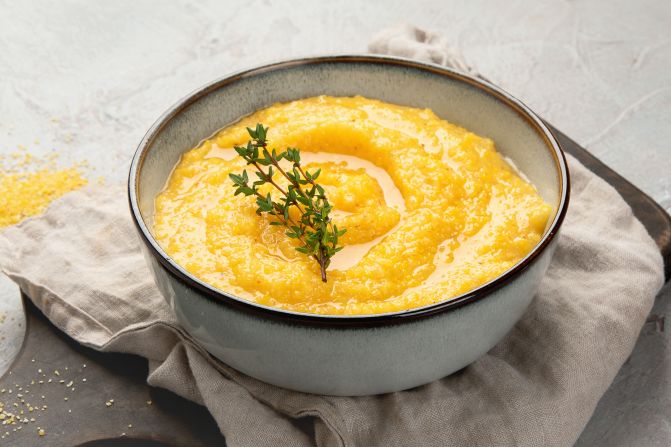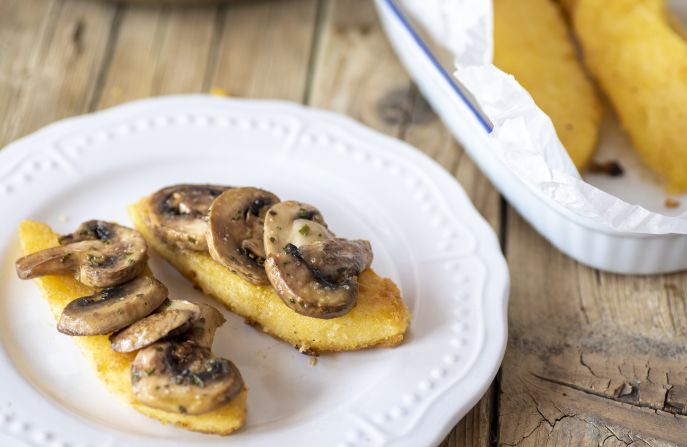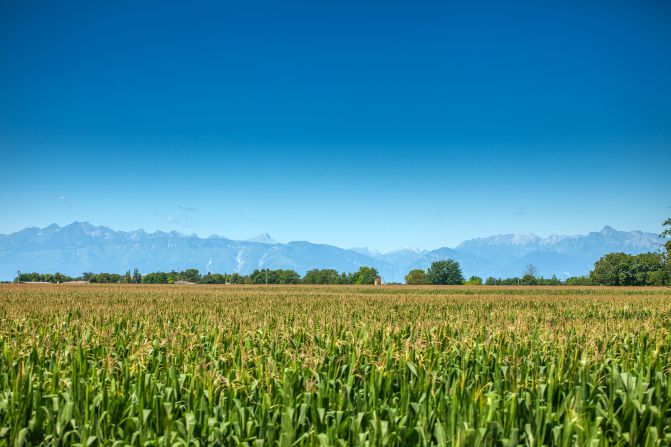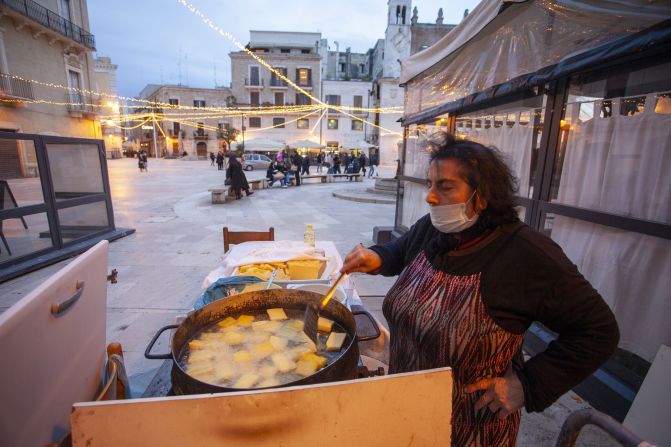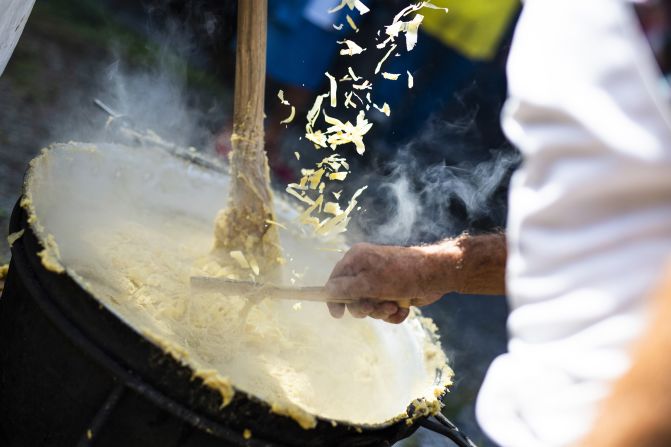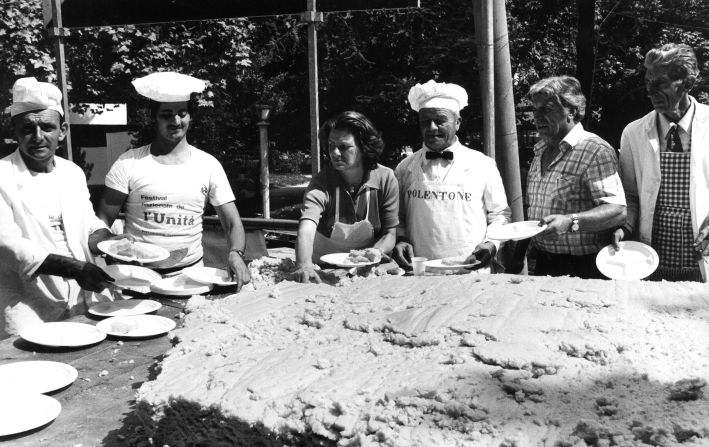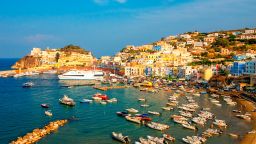It’s golden, grainy, sticky and tastes rather bland if served on its own.
But the sheer versatility of polenta has transformed it into a culinary star, with Italy’s famed boiled cornmeal dish pairing nicely with an endless number of flavors.
Toppings can include everything from venison, fish, rabbit, wild boar and braised veal to mushrooms, tomato sauce and melted cheese. It can also be used in desserts, including biscuits, pies and pancakes. Some even eat it with Nutella.
And one can’t forget the textures. It comes in many forms and can be chewy, gluey, crispy or extremely creamy.
Polenta is eaten across Italy, but there are three main regions in the country’s north where it’s particularly popular – Veneto, Lombardy and Piedmont.
Giovanna Gilli, 85, has fond memories of her own Piedmontese grandmother slowly stirring the cornmeal mush inside a huge paiolo copper cauldron on the fireplace, then serving it on a wooden table, pouring tomato sauce, sausages and onions over it before everyone grabbed their share.
“We’d take a spoonful and put it in our plates. It was delicious, melting in my mouth,” she recalls.
“The next day, the leftover dried crunchy polenta was cut into sticks for us kids to dip into milk or sprinkle with sugar for breakfast.”
Thanks, Christopher Columbus
Today, polenta is believed to be Italy’s most popular staple food after pasta and pizza. At its core it remains a humble communal dish, but during the WWII years was eaten mainly out of necessity.
At the end of a hard day’s work, some family members would gather around the table and share polenta the pica sö way. Using their hands as spoons, they would rub each bite against a dried herring hanging with a string from the kitchen ceiling to give the plain polenta more flavor while conserving the fish.
Though food historians note that ancient Romans used to eat a softer type of polenta that was made with cooked ground spelt, the version people know and love today has its roots across the Atlantic Ocean, in the Americas.
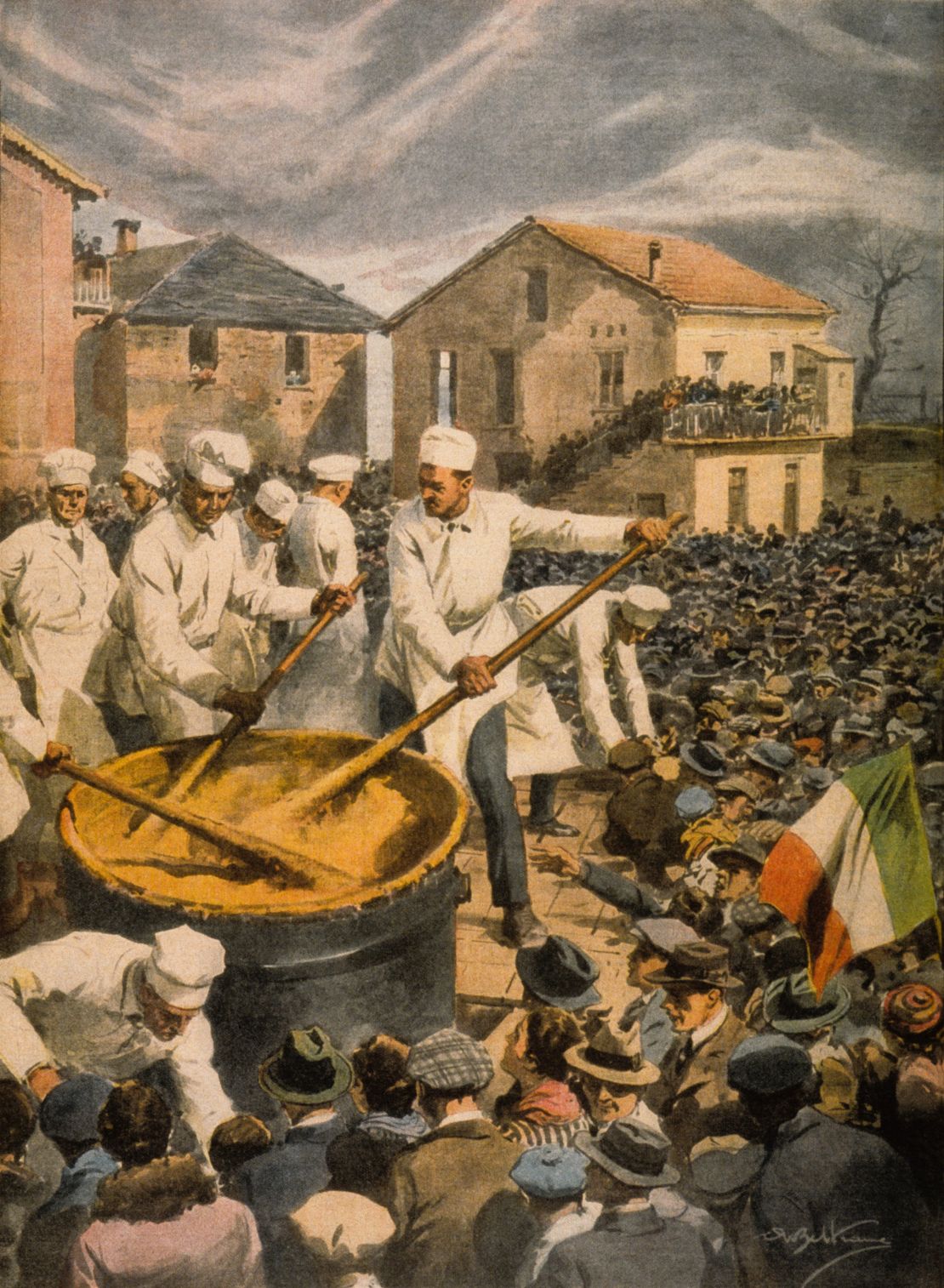
It all started when Christopher Columbus brought the “exotic” crop of maize, or corn, back with him to the Old Continent, which was unfamiliar with the commodity until his voyage in 1492.
According to chef and food historian Amedeo Sandri, maize was later imported to Italy by missionaries returning from the Americas to the region of Friuli.
Large-scale cultivation spread in the 1600s to Veneto and Lombardy, replacing traditional crops and triggering an agrarian revolution. Today, there are a dozen or so types of Italian corn grown in the country.
“Farmers realized that maize had a higher yield and shorter cultivation cycle compared to millet, rye and wheat, and that it gave enough strength to work in the fields,” says Sandri.
“But there were some serious side-effects to this polenta-based diet.”
Northerners are said to have gotten so addicted to plain boiled cornmeal that they developed a peculiar disease called pellagra, caused by a lack of niacin – otherwise known as vitamin B3. Many reportedly suffered from dementia, diarrhea and skin rashes as a result of the illness.
However, advances in nutritional research in the early- to mid-20th Century and more diversified diets changed all that and, in the years to follow, Italians discovered the benefits of including polenta in a balanced meal.
For one, it’s gluten-free, making it an ideal side for those with celiac disease. Health experts say it’s easily digestible and low in calories.
“It is extremely nutritive, there are many varieties and color shades depending on the consistency, toppings, area of production and corn type,” says Anna Maria Pellegrino of Italy’s Cuisine Academy.
“Given the delicate taste it’s always paired with other foods.”
‘It’s part of our DNA’
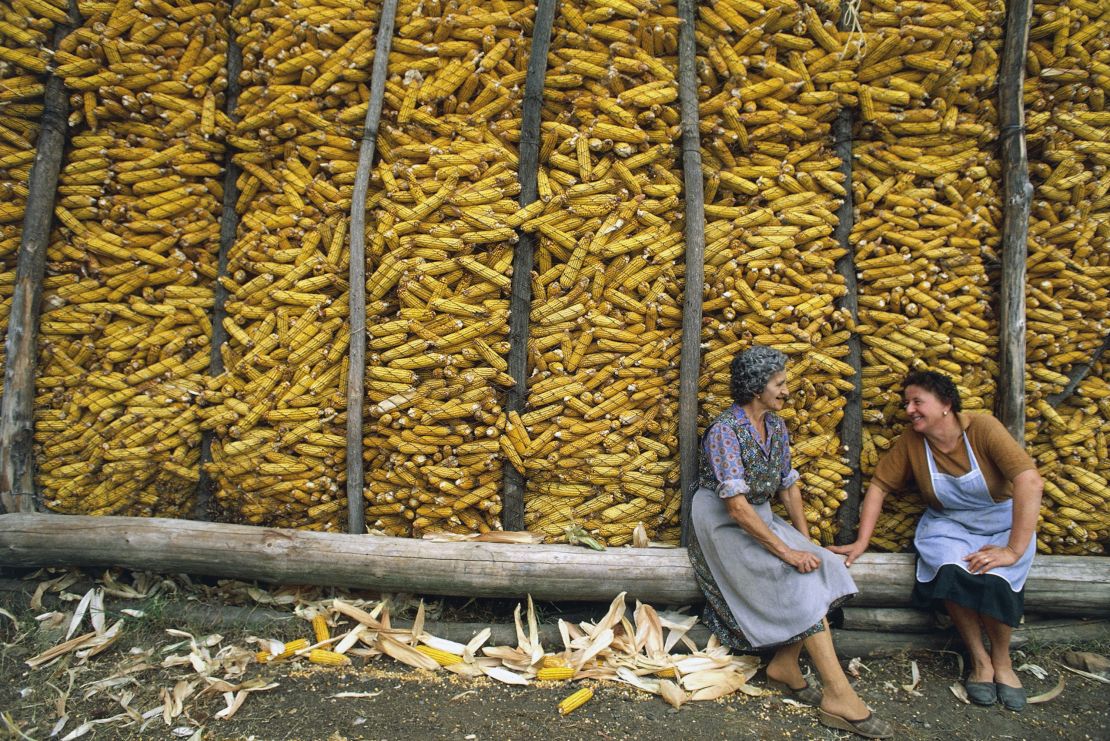
Polenta basically comes in two varieties: hot, semi-liquid or solidified and served in rectangular sticks – finger foods that are either fried in butter or olive oil, or grilled and then left to cool.
In the northern mountainous areas of Piedmont, Lombardy and Valle D’Aosta it’s dense and bright yellow. Further south in the valleys it’s softer and ivory-colored, while along Veneto’s coast it has a velvety, whitish shade – the result of being made with the premium biancofiore maize that pairs well with codfish, herring and squid.
When it comes to urban centers, the cities of Bergamo and Brescia are where polenta cults really flourish.
“It’s part of our DNA, like Amatriciana for Romans. On Sundays polenta lunches are our religion,” says Marco Pirovano, owner of PolentOne, a street-food bistro serving takeaway polenta with creative twists.
“We like to have it the ‘pucio’ way, with a hole in the middle to pour sauce or broth that soaks up inside. Polenta in Bergamo must be so thick and dense it glues to the plate if you turn it over and can be sliced with a string.”
As northern Italians are the biggest eaters of polenta, southerners jokingly call them “polentoni”, a slightly denigratory term which has come to mean “dense and sluggish” – just like cornmeal mush.
But Pirovano prides himself on being a “polentone.”
“I named my eatery after it,” he says. “When I go to the ballot boxes to vote I just scribble ‘Go Polenta!’ on the paper.”
Pirovano has even patented a so-called “draught polenta” machine that prepares it as fast as an espresso and is made with a type of ancient maize flour that was ground in an old stone mill.
Offering modern takes on the Italian classic, his restaurant’s polenta bites are topped with yogurt, bacon, salad, sprinkled sugar and mozzarella cheese.
Little birds, big controversy
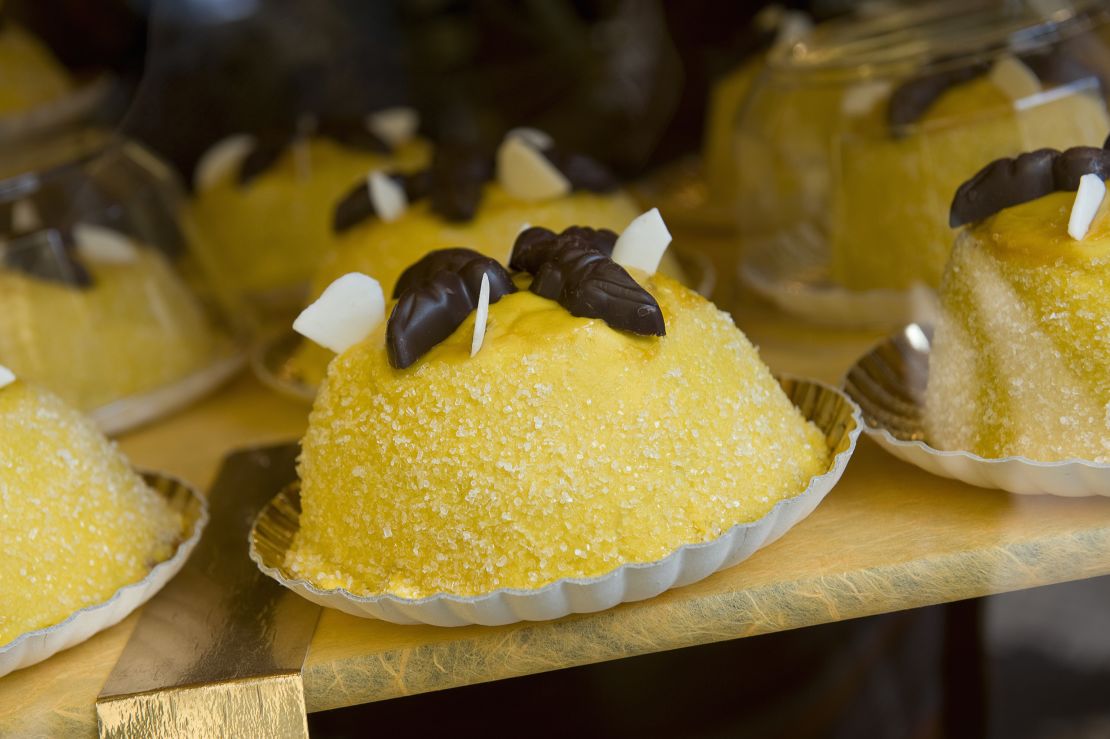
In spite of its perceived plainness, polenta isn’t immune to culinary controversies – at least where toppings are concerned.
Among the favorite polenta pairings in northern Italy are osei – “little birds” – an obsession that has led to multiple court cases and attracted the ire of wildlife conservationists, including WWF Italy.
In 1992, the European Union banned the hunting of protected bird species such as sparrows, blackcaps, starlings, larks, woodpeckers, robin redbreasts and nightingales – all birds once favored by hunters and polenta e osei fans.
The only species that could be hunted and eaten legally were five species of thrush, starlings and skylarks.
Then, another heavy blow for polenta osei fans came in 2005 when the EU banned all wild bird trade, including the species that were permitted to be hunted. This meant hunters could no longer sell their catches to restaurants and food fairs, so many business owners removed the dish from menus.
But private households continued to celebrate the weekend hunt with steaming pots of polenta e osei, and hunters reportedly kept selling their birds to “speakeasy” taverns on the sly.
Court cases continued over the years, with locals and politicians bristling at the bans. Campaigns were waged and exemptions and loopholes inevitably emerged.
In 2022, for instance, the regional authorities of Lombardy lifted the bird trade ban, citing the area’s historical and cultural connection to its traditional osei dishes. However there’s one rule – the hunter needs to give its osei to the customer free of charge.
“Truth is, we’ve always eaten little birds, those that are legal, of course,” says Piero Dominoni, owner of mountain hut tavern Rifugio Cespedosio in the village of Camerata Cornello, near Bergamo.
“It’s part of our soul, we can’t give up on that. The ban lift movement started right from our village. Protected birds remain off-limits but all other legal osei are fair game including thrushes, blackbirds, fieldfares, snipes and pheasants and aquatic birds.”
According to Sandri, proprietors in Italy’s Veneto region aren’t letting the trade restrictions stop them either.
“The region hasn’t lifted the ban but everyone here keeps buying and eating the legal osei,” he says. “Hunters just got smarter and say they’re gifting their catch to restaurants.”
